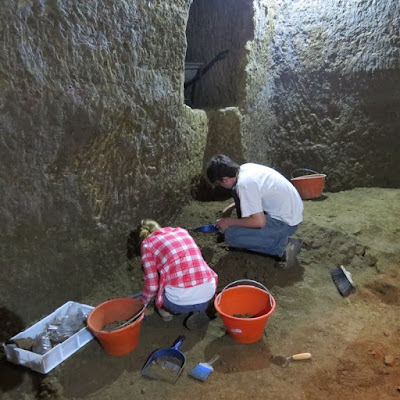Excavation on the west wall of the hypogeum near the Etruscan tunnel that connects this pyramidal hypogeum (Room A) with an adjacent one (Room B). Courtesy Daniel George, Jr.
Archaeologists
are scratching their heads about an underground pyramid-shaped
structure they have been excavating beneath the historic medieval town
of Orvieto in Italy. But it may not be a mystery forever. They hope to
find answers as they continue to tease artifacts and architectural
materials from the soil.
"We
discovered it three summers ago and still have no idea what it is,"
write Prof. David B. George of St. Anselm College and co-director
Claudio Bizzarri of PAAO and colleagues about the site. "We do know what
it is not. It is not a quarry; it’s walls are too well dressed. It is
not a well or cistern; its walls have no evidence of hydraulic
treatments."*
Calling
it the "cavitá" ('hole' or 'hollow' in Italian), or hypogeum, the
archaeologists have thus far excavated about 15 meters down. They marked
their third year at the site in 2014. By then they had uncovered
significant amounts of what they classify as Gray and Black bucchero, commonware, and Red and Black Figure pottery remains. They have dated deposits to the middle to the end of the 6th century BCE.
"We
know that the site was sealed toward the end of the 5th century BCE,"
George, et al. continue. "It appears to have been a single event. Of
great significance is the number of Etruscan language inscriptions that
we have recovered – over a hundred and fifty. We are also finding an
interesting array of architectural/decorative terra cotta."*
READ MORE
Tuesday, March 15, 2016
Por-Bazhyn
Por-Bazhyn from the air (looking northwest) before excavation in 2007.
3-D reconstruction drawing of Por-Bazhyn based on excavation results
2007/8 (by R.A. Vafeev)
Vajnstejn's plan of the site (updated 2007 for the Por-Bajin Fortress Foundation)
Por-Bazhyn (Por-Bajin, Por-Bazhyng,) is the name of a ruined
structure on a lake island high in the mountains of southern Tuva (Russian
Federation). The name Por-Bazhyn translates from the Tuvan language as
"clay house". Excavations suggest that it was built as an Uyghur
palace in the 8th century AD, converted into a Manichaean monastery soon after,
abandoned after a short occupation, and finally destroyed by an earthquake and
subsequent fire. Its construction methods show that Por-Bazhyn was built within
the Tang Chinese architectural tradition.
Por-Bazhyn is a 1,300-year-old structure of 7 acres that
takes up most of the small island on which it sits. Containing a maze of over
30 buildings, its high outer walls sit only 30 kilometers (20 mi) from the
border with Mongolia. But over a century since its discovery, archaeologists
are no closer to understanding who built this structure or why.
At first, researchers thought Por-Bazhyn was an ancient
fortress of the Uighur Empire, nomads who ruled southern Siberia and Mongolia
from 742–848. It’s constructed with a Chinese architectural style from that
time. However, it’s so out of the way of trade routes and other settlements
that competing theories eventually arose. Maybe it was a monastery, a summer
palace, a memorial for a ruler, or an observatory for the stars. Evidence is
accumulating that a Buddhist monastery was at the center of the complex,
although only a few artifacts have been unearthed.
The complex does not appear to have been inhabited for long.
Archaeologists found indications of earthquakes that may have caused a fire
that burned some of the original site. However, the fire appears to have
occurred after the island was abandoned for reasons unknown.
Subscribe to:
Comments (Atom)



